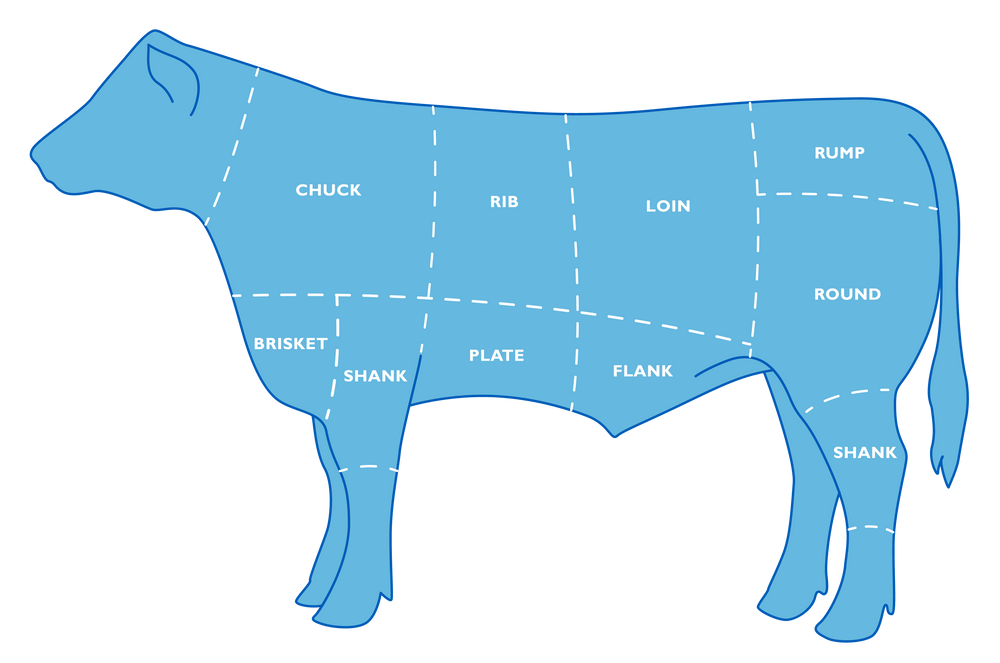
BEEF CUTLIST Vs. BEEF SHARE
When you receive a cut list from us, it means you’ve taken a big step—you’ve handpicked your own animal from our pastures. This personalized approach ensures that you know exactly where your beef comes from, and it gives you the freedom to make specific decisions about how your whole or side of beef is butchered. It’s a unique opportunity to tailor your beef exactly to your preferences, making the experience as satisfying as the meals you’ll prepare.
For those who choose a beef share instead, after a brief interview with you, we handle most of the decision-making. We take the guesswork out of the process, selecting the cuts we know will give you the best variety and value. This option is perfect if you prefer to leave the details to us, trusting our expertise to provide you with a well-rounded selection of delicious, high-quality beef cuts and a smattering of something new.
STEW MEAT AND HAMBURGER
Even if you opt for the maximum number of roasts and steaks, you’ll still end up with about 60 lbs. of ground beef or stew meat. That’s because there’s always a lot of perfectly good meat that’s just not the right shape or size for roasts and steaks. If you want more hamburger or stew meat, you can make choices to increase your total. Just specify at the end of the cut-sheet how many pounds of stew meat per package and how many packages you’d like. We’ll use lean pieces that would otherwise be ground into hamburger.
CHUCK
The chuck section is a hefty one, with about 40 pounds of meat and bones per side. While it’s often ground into hamburger, you can also get 4 or 5 chuck and shoulder roasts, which are perfect for pot roasts and other slow-cooked meals. Let us know how many roasts you’d like, and we’ll grind the rest. Fun fact: about 4 lbs. of short ribs come from the chuck. You can keep them on the bone or have them ground—your call!
RIB
This section yields around 15 lbs. of bone-in or 10 lbs. of boneless high-quality steaks or roasts. Think steakhouse prime rib, but with less fat, grading at “choice” or “select.” If you go for all steaks, you’ll get about 10 steaks, 1¼” thick, each weighing about 1½ lbs. bone-in or 1 lb. boneless. Prefer roasts? You can get three small, two medium, or one giant roast fit for the Flintstone family.
SHORT LOIN
Here’s where you get the crème de la crème of beef cuts. The short loin gives you T-bone steak, Porterhouse, NY strip steak, and filet mignon. Want the whole tenderloin as a roast? That means no T-bones or Porterhouses, as they include a piece of tenderloin. With steaks cut at 1” thick, you’ll get about 10 from a side. 1.5" thick yeild about 6 steaks each. And if you choose T-bones and Porterhouses, you’ll get a small bonus of extra tenderloin, thanks to a little piece that extends beyond the short loin. I call these the bonus tendies!
SIRLOIN
The sirloin offers around 16 lbs. of beef per side. Choose to have it cut into a variety of bone-in and boneless steaks, or grind it all for a flavorful addition to your ground beef. If you’re a fan of the popular tri-tip roast, we can cut that from the sirloin too—it’s about 2 lbs. of deliciousness. Other options are picanha, fajita strips (unseasoned, but sliced and trimmed and ready to go), kabob bites.



Leave a comment
Also in Farm Blog
What’s the Difference Between A1 and A2 Milk
Ever wonder if Creamery Creek milk is A1 or A2? The truth is, it’s a natural blend. Our Holstein herd includes both A1A2 and A2A2 cows, and while we track it through genomic testing, we don’t separate the milk. Here’s what that means and why we care about it.
Keep reading
Behind the Scenes: How Your Order Ships from Our Farm
Ever wonder what happens after you click “Place Order”? Take a peek behind the scenes to see how your Creamery Creek box is packed, shipped, and delivered straight from our family farm with care and attention in every step.
Keep reading
What’s Really Going On With Imported Beef
There’s been a lot of talk lately about importing more beef from Argentina to “lower prices.” As a beef and dairy farmer, I wanted to share what that really means from our side of the fence. The truth is, cheaper imports don’t fix the challenges facing American farms, they just make it harder for family operations to survive. Here’s what’s really going on and why local beef still matters.
Keep reading